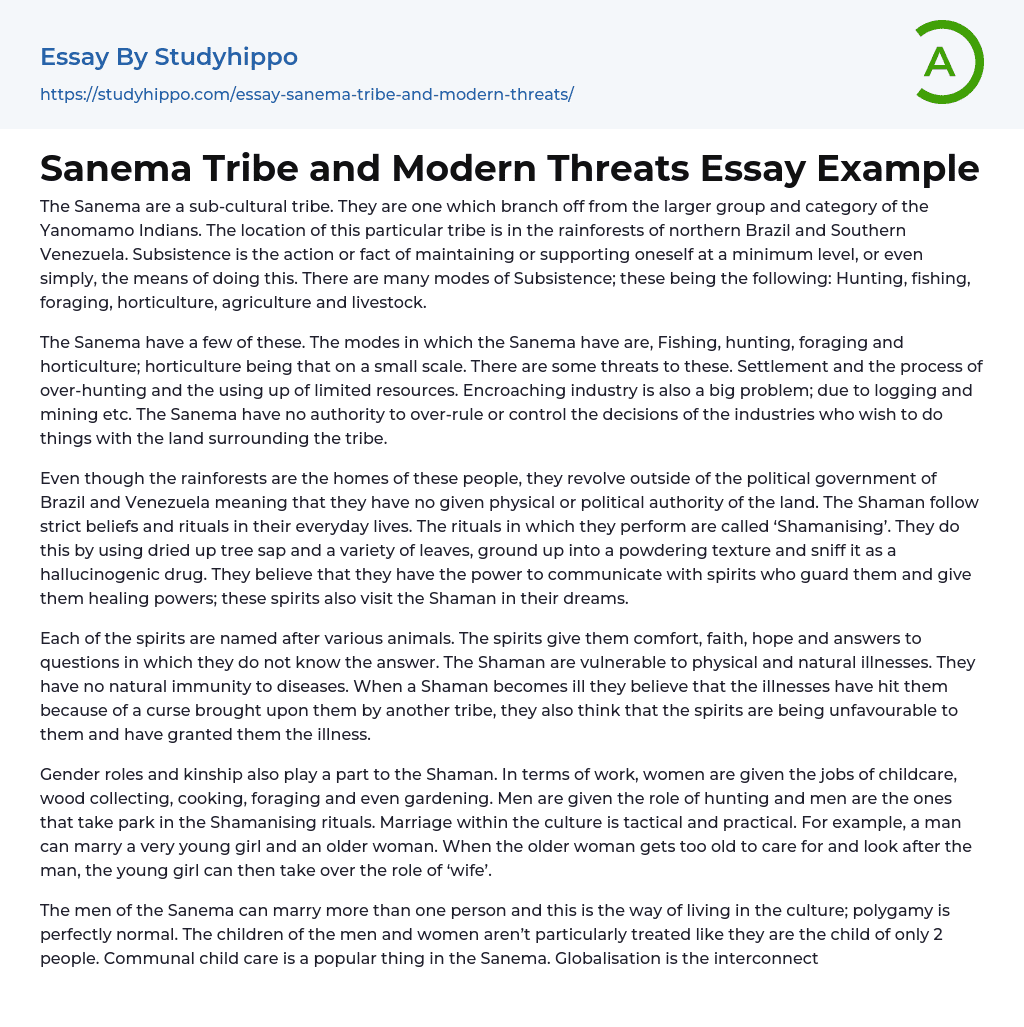The Sanema are a sub-cultural tribe. They are one which branch off from the larger group and category of the Yanomamo Indians. The location of this particular tribe is in the rainforests of northern Brazil and Southern Venezuela. Subsistence is the action or fact of maintaining or supporting oneself at a minimum level, or even simply, the means of doing this. There are many modes of Subsistence; these being the following: Hunting, fishing, foraging, horticulture, agriculture and livestock.
The Sanema have a few of these. The modes in which the Sanema have are, Fishing, hunting, foraging and horticulture; horticulture being that on a small scale. There are some threats to these. Settlement and the process of over-hunting and the using up of limited resources. Encroaching industry is also a big p
...roblem; due to logging and mining etc. The Sanema have no authority to over-rule or control the decisions of the industries who wish to do things with the land surrounding the tribe.
Even though the rainforests are the homes of these people, they revolve outside of the political government of Brazil and Venezuela meaning that they have no given physical or political authority of the land. The Shaman follow strict beliefs and rituals in their everyday lives. The rituals in which they perform are called ‘Shamanising’. They do this by using dried up tree sap and a variety of leaves, ground up into a powdering texture and sniff it as a hallucinogenic drug. They believe that they have the power to communicate with spirits who guard them and give them healing powers; these spirits also visit the Shaman in their dreams.
style="text-align: justify">Each of the spirits are named after various animals. The spirits give them comfort, faith, hope and answers to questions in which they do not know the answer. The Shaman are vulnerable to physical and natural illnesses. They have no natural immunity to diseases. When a Shaman becomes ill they believe that the illnesses have hit them because of a curse brought upon them by another tribe, they also think that the spirits are being unfavourable to them and have granted them the illness.
Gender roles and kinship also play a part to the Shaman. In terms of work, women are given the jobs of childcare, wood collecting, cooking, foraging and even gardening. Men are given the role of hunting and men are the ones that take park in the Shamanising rituals. Marriage within the culture is tactical and practical. For example, a man can marry a very young girl and an older woman. When the older woman gets too old to care for and look after the man, the young girl can then take over the role of ‘wife’.
The men of the Sanema can marry more than one person and this is the way of living in the culture; polygamy is perfectly normal. The children of the men and women aren’t particularly treated like they are the child of only 2 people. Communal child care is a popular thing in the Sanema. Globalisation is the interconnectedness of the people worldwide. Increase in globalisation means that communications throughout the world are becoming faster and wider reaching.
The Sanema are under threat from multi-national companies and large industries seeking new resources.
Structural expansions from things such as road and railway building can become an economic crisis to the people of the Sanema. The building of these types of things can put the livelihood, culture and well-being of the Sanema people at risk. Cultural relativism includes the process of not being opinionated towards other cultures. For example, drug taking in the Sanema is an important cultural activity done by high status community members.
In Western culture drug use is criminalised and seen as very harmful to health. However, when Bruce Parry visited the Sanema, he carried out an ethnography which means he lived with them for a short while to learn their way of life and become one of the tribe. Within this time he learnt of the way in which they survive and worship the spirits. He took part in the rituals and even took part in the sniffing of the hallucinogenic drugs. This is an example of cultural relativism and gives a great insight into the culture of the Sanema.
- Child essays
- Child labor essays
- Childcare essays
- Anthropology essays
- Audience essays
- Charity essays
- Cultural Competence essays
- Emile Durkheim essays
- Gender Roles essays
- Generation essays
- Globalization essays
- Interpersonal Relationship essays
- People essays
- Race essays
- Social Change essays
- Social Class essays
- Social Movement essays
- Social Science essays
- Social Status essays
- Social Stratification essays
- Society essays
- Sociological Imagination essays
- Sociological Perspective essays
- Sociological Theories essays
- Stereotypes essays
- Web Dubois essays
- Activity essays
- Believe essays
- Comfort Zone essays
- Dance essays
- Fashion essays
- Fishing essays
- Fitness essays
- Freedom essays
- Habits essays
- Healthy Lifestyle essays
- Hobby essays
- Hunting essays
- Interests essays
- Justification essays
- Moment essays
- Optimism essays
- Peace essays
- Perfume essays
- Shoes essays
- Shopping essays
- Silence essays
- Superstition essays
- Survival essays
- Vegetarianism essays


Unfortunately copying the content is not possible
Tell us your email address and we’ll send this sample there.
By continuing, you agree to our Terms and Conditions.


